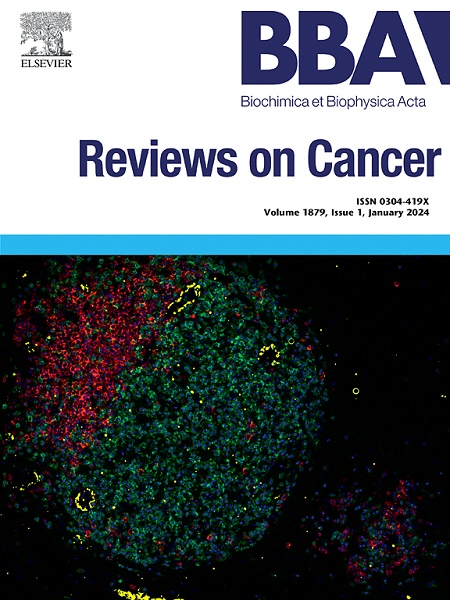Experimental toolkit to study the oncogenic role of WNT signaling in colorectal cancer
IF 9.7
1区 医学
Q1 BIOCHEMISTRY & MOLECULAR BIOLOGY
Biochimica et biophysica acta. Reviews on cancer
Pub Date : 2025-05-23
DOI:10.1016/j.bbcan.2025.189354
引用次数: 0
Abstract
Colorectal cancer (CRC) is linked to the WNT/β-catenin signaling as its primary driver. Aberrant activation of WNT/β-catenin signaling is closely correlated with increased incidence, malignancy, poorer prognosis, and even higher cancer-related death. Research over the years has postulated various experimental models that have facilitated an understanding of the complex mechanisms underlying WNT signaling in CRC. In the present review, we have comprehensively summarized the in vitro, in vivo, patient-derived, and computational models used to study the role of WNT signaling in CRC. We discuss the use of CRC cell lines and organoids in capturing the molecular intricacies of WNT signaling and implementing xenograft and genetically engineered mouse models to mimic the tumor microenvironment. Patient-derived models, including xenografts and organoids, provide valuable insights into personalized medicine approaches. Additionally, we elaborated on the role of computational models in simulating WNT signaling dynamics and predicting therapeutic outcomes. By evaluating the advantages and limitations of each model, this review highlights the critical contributions of these systems to our understanding of WNT signaling in CRC. We emphasize the need to integrate diverse model systems to enhance translational research and clinical applications, which is the primary goal of this review.

研究WNT信号在结直肠癌中的致瘤作用的实验工具。
结直肠癌(CRC)与WNT/β-catenin信号作为其主要驱动因素有关。WNT/β-catenin信号的异常激活与发病率增加、恶性、预后差,甚至更高的癌症相关死亡密切相关。多年来的研究已经假设了各种实验模型,这些模型有助于理解CRC中WNT信号传导的复杂机制。在本综述中,我们全面总结了用于研究WNT信号在CRC中的作用的体外、体内、患者衍生和计算模型。我们讨论了CRC细胞系和类器官在捕获WNT信号分子复杂性和实施异种移植和基因工程小鼠模型来模拟肿瘤微环境中的应用。患者衍生模型,包括异种移植物和类器官,为个性化医疗方法提供了有价值的见解。此外,我们详细阐述了计算模型在模拟WNT信号动力学和预测治疗结果中的作用。通过评估每个模型的优点和局限性,本综述强调了这些系统对我们理解CRC中WNT信号传导的重要贡献。我们强调需要整合不同的模型系统,以加强转化研究和临床应用,这是本综述的主要目标。
本文章由计算机程序翻译,如有差异,请以英文原文为准。
求助全文
约1分钟内获得全文
求助全文
来源期刊

Biochimica et biophysica acta. Reviews on cancer
医学-生化与分子生物学
CiteScore
17.20
自引率
0.00%
发文量
138
审稿时长
33 days
期刊介绍:
Biochimica et Biophysica Acta (BBA) - Reviews on Cancer encompasses the entirety of cancer biology and biochemistry, emphasizing oncogenes and tumor suppressor genes, growth-related cell cycle control signaling, carcinogenesis mechanisms, cell transformation, immunologic control mechanisms, genetics of human (mammalian) cancer, control of cell proliferation, genetic and molecular control of organismic development, rational anti-tumor drug design. It publishes mini-reviews and full reviews.
 求助内容:
求助内容: 应助结果提醒方式:
应助结果提醒方式:


